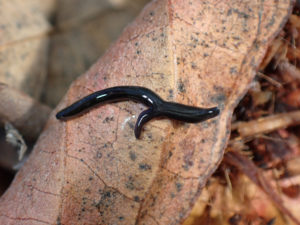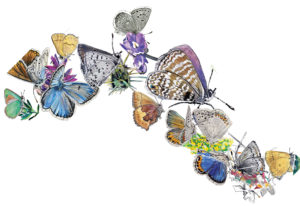The old saw about weather in San Francisco—if you don’t like it, walk a block—could also be applied to Bay Area soils. Nonconformity in Bay Area rocks, along with varied topography, climate, and vegetation, has resulted in a great variety of native soils.
In addition to natural processes, human factors also greatly influence the composition of a soil. The soils of our residential landscapes have often been graded, reshaped, cut, or filled, resulting in melanges that confound even soil scientists. Given this variety, it is safe to say that there is no one correct way to approach the soil in your own yard. However, gardeners and soil scientists agree that all soils can benefit from nurture, and that getting to know your local soil is rewarding in itself and can yield big payoffs in the garden. This series of profiles of gardeners begins with two caretakers who helped bring degraded soils back to life.
Tackling Compaction and Degradation
When Ben Weil and his family moved into a flat on Telegraph Avenue in Oakland, the 15- by 20-foot backyard was overgrown with weeds and featured a moldering synthetic carpet. When Weil began to work the soil, he found a lot of debris. “We dug out scraps of wood and shingles; we were filling the garbage can each week.” A year later, Weil says the earthworms are now digging up old nails, bits of glass, and other remnants of the land’s past uses: “They keep bringing stuff to the surface, from way down below.”
Despite excellent qualifications—Weil has an undergraduate degree in soil science and his father coauthored a well-known textbook on soils—this garden is the first where Weil has had full play. “Things didn’t work well the first season,” he says. “It was so compacted, there was no aeration, and the soil had lost aggregate strength entirely. It was really pretty dead.”
To get a shovel into the ground, Weil had to jump on it with both feet. He dug to the depth of the shovel and then used a three-pronged hoe to work in amendments—worm castings and aged chicken manure. Weil also experimented with planting a seed mix that helped open the soil and return nutrients to it.
“My dad was doing some cover crop research. He had a mix of daikon radish, crimson clover, and rape. The radish,” Weil explains, “was to aerate the soil, the clover was to fix nitrogen, and the rape was to hold the nitrogen and return it to the soil when it was turned under.”
Weil planted in November and, in March, when the plants had just begun to flower, he cut them back to ground level and composted the leaves and stems. Where he planned to put in flowers or vegetables, he dug the cover crop into the ground and then planted. This time around, the soil—which Weil characterizes as clayey loam—was much easier to turn. “Those big daikon radishes loosened the soil,” he says, “and the worms found the place. They really turned the soil for me.”
Sharon McCray, certified as a Master Gardener through UC Cooperative Extension, is a big proponent of cover crops as well. When she worked with the City of Campbell to start the Edith Morley Park Community Garden in late 2000, she recommended planting green manures—another name for cover crops—over the winter.
Located in the floodplain of Stevens Creek, the sandy soil of Edith Morley Park was in dire need of some loving attention. For 50 years, it had been the site of a drive-in theater, buried beneath a six-inch layer of asphalt. When a business park across the street was completed, the City of Campbell began to develop the park.
McCray and her fellow gardeners faced some challenges with the low-nutrient, severely compacted soil. McCray recommended seeding clovers and other legumes as cover crops. “Between flower and fruit set is the best time to cut down the plants and let them rest on top of the soil,” McCray explains. “This adds organic material to the soil. And the nitrogen-producing nodules in the roots will break down naturally to increase the nitrogen in the soil.”
Adding commercially produced nitrogen is avoided at the garden. When it comes to fertilizers, McCray says, “more is not better.” Nancy Garrison, former program coordinator for the UC Cooperative Extension Master Gardeners in Santa Clara County, seconds this point of view. Master Gardeners “promote the responsible use of organic fertilizers where needed,” she says, and “discourage overuse of nitrogen because it gets into groundwater and can become a contaminant in our creeks and the Bay.” Stormwater runoff also carries garden fertilizers and pesticides into our waterways.
Nitrogen impacts aquatic systems by overloading them with nutrients, which cause some water plants to bloom profusely. This overgrowth can clog the waterways, blocking sunlight and destroying habitat for many aquatic organisms. As it dies off, this plant growth also uses up oxygen in the water, depriving fish, insects, and other plants that need it to live. “The number one polluter to San Francisco Bay is the home gardener,” McCray claims. “If you have to fertilize, use half as much twice as often. Corn and grass are heavy nitrogen feeders; otherwise nothing needs it.”
McCray suggests that gardeners sometimes overfertilize because the plants they buy at the nursery have been raised on plant foods in artificial environments. “Nursery plants,” she says, “can suffer shock when they’re put in the ground.” Asking how nursery plants are cared for, and choosing plants—especially natives—that can make do without chemical inputs, is a good way to reduce the temptation to fertilize at home.
Instead of feeding plants, feed the soil. Add organic materials, in the form of mulch or compost. McCray and Garrison agree that homemade compost is the one soil amendment you can never have too much of. The plants at Edith Morley are clearly not starved of nutrients: Tidy rows of garden plots—filled with fruit, vegetables, and flowers—greet the visitor. “This is what can be done when you reclaim a place,” says McCray, with satisfaction. “You can take it back.”
Working with Clay
Many Bay Area residents are familiar with clay soils. They dominate central Contra Costa and parts of Alameda County. They can be found in lowlands all around the Bay and in some uplands of Santa Clara County; they are also common in Marin.
“Clays are unique,” says Lisa Hokholt of the U.S. Department of Agriculture’s Natural Resources Conservation Service in Contra Costa County. “In general, they contain charged particles. Sand and silt don’t.” This makes clay chemically reactive, which means, among other things, that clay particles hold on to plant nutrients and have an affinity for water. And because clay particles are so very, very small, they have a tremendous amount of surface area to which nutrients and water molecules can adhere—a pound of clay has a particulate surface area of more than 90 acres.
“Clay can be very productive,” Hokholt adds. “Unless you live in an area with a high water table, you’re going to be able to garden in clay soils. You’re dealing with hard digging conditions,” she acknowledges, but not impossible ones. To every gardener, she offers this advice: “Work with what Mother Nature has dealt you.”
Bethallyn Black has been working with clay soils almost all her life. She is a lifelong Contra Costa resident who, for the last eight years, has managed the UC Cooperative Extension Master Gardener program in the county.
Clay soils are incredibly rich, says Black, but air and water are slow to move through them. Plant roots, Black adds, can also have a hard time spreading through clay soils. The best remedy, she says, is organic material. “In our Mediterranean climate, we don’t have organic matter falling all the time,” she explains. “So you should be adding as much organic matter as you can get your hands on. Get free, chopped up organic matter any way you can.”
For annual plantings, Black recommends working organic material into the soil—amending it—every fall. For perennial beds and other permanent plantings, she suggests piling mulch three to four inches thick and renewing as needed. Coffee grounds are a good amendment for clay because they’re high in nitrogen and they lower pH. (According to Black, most clays have a high pH; a neutral soil is optimum for most plants.) For mulching, she recommends shredded pine needles because they’re slightly acidic.
For success in clay, Black also stresses the importance of plant choice. “We live in an area where there’s an explosive plant palette. It’s possible to grow so many different plants here, but those possibilities have to be coupled with an understanding of the site.”
Black believes that the bones of a garden—the permanent plantings—should be locally appropriate. Contra Costa County, for example, “was formerly a dry grassland,” says Black, “not an urban forestry corridor. Until Sierra water was brought in, it was impossible to garden here. Gardens here are as out of place as bougainvillea and palm trees in the desert.”
Black’s home garden lies in a floodplain below Mount Diablo where, after a series of winter rains, groundwater reaches the surface of the clay soil. She says she’s had less success with the native chaparral shrubs, such as manzanita and fremontodendron, which require good drainage, but miscanthus, or deer grass, has done well in her yard.
Chris Dundon, a landscape architect with the Contra Costa Water District who also lives in central Contra Costa, says perennial bunchgrasses are one of the best plants to start with, because they’re what’s native to the area. He’s also had success with many native buckwheats and California coffeeberry.
Pat Bacchetti has been a gardener all her life, growing vegetables with her family at their farm in Tracy and then focusing on flowers as an adult. Bacchetti chose what was pretty, and she had a passion for orchids—and then she moved into her current home near Rockridge in Oakland.
Most of her lot is taken up by a steep, north-facing slope that was planted with acacia and stunted fruit trees. According to Bacchetti, “I took a year to ask myself, ‘What is it I have here? What can I do with this space?’” She also took a class—and began her own transformation as a gardener.
“I took a shrub class taught by Glenn Keator at the Academy of Sciences,” Bacchetti explains, “and it opened my eyes up to the world.” She learned to recognize California hazelnut and other native shrubs that grow wild on our hillsides. “That got me into restoration,” Bachetti says. She realized she had stumbled upon a way to garden on her steep slope “and give it back to nature.”
“The slope is clay,” Bacchetti says, “It’s really hard!” With the help of two people and three shovels, Bacchetti put in 80 mostly native shrubs, both small and large. Before planting, she applied a thin layer of compost, which she bought from American Soil Products, on the surface. She waited until after two good soaking rains, so the nutrients from the compost would have a chance to sink in and the clay became saturated. Then she planted. Afterwards, Bacchetti put down a mulch of shredded bark to prevent erosion.
During this winter’s rainy season, Bacchetti plans to replant two terraces at the bottom of the garden, which the previous owners had laid with sod. She will be putting in a meadow of native bulbs and grasses. Work on that project began last summer, when Bacchetti killed the lawn by not watering it. In the fall, she sheet mulched—that is, she put down a biodegradable barrier, a layer of cardboard—and then planted directly into the cardboard. After that she spread a layer of wood chips over the top of the cardboard.
She’s looking forward to seeing what the spring will bring.
Minimizing Soil Disturbance
It is widely recognized that tilling the soil too often can destroy it. A growing number of gardeners are choosing to do less with their soil, in order to help it live more. Such gardeners avoid digging in the soil, aside from what’s necessary to put plants in the ground; many grow local native plants that are adapted to their soil, and they leave organic material in place.
Arvind Kumar has a three-year-old native garden in San Jose. He characterizes his soil as “good old Santa Clara Valley clay” and says that it was probably graded and leveled by bulldozers.
Kumar’s approach to his site and soil has been to plant what is locally native and appropriate. He is one of the organizers of the Going Native Garden Tour that takes place each spring in the South Bay and an eloquent spokesperson for the advantages of gardening with native plants.
“As much as I love redwood forests and Sierra meadows,” Kumar says, “I have no wish to replicate them in my San Jose yard. I want to try to reproduce, even if only on a small scale, what might have existed in the Santa Clara Valley before it was paved and urbanized. I look out for plants that do well in clay.
“My view,” explains Kumar, “is that no garden or soil is difficult. For every type of soil, there is an appropriate type of plant. You just need to find it. It is much easier (not to mention environmentally sound) to change the plants to suit the site than the reverse. Azaleas are beautiful—in moist redwood forests. Trying to grow them in San Jose is not only hard work, but a colossal waste of water and other resources.”
Though Kumar focuses on plant choice as a primary means to work with his soil, he does amend it with organic matter. He uses mulch to control weeds and he loosens the clay a little with homemade compost before planting. “But,” Kumar says, “I don’t try too hard to make my clay soil into something it isn’t and will never be: the fast-draining, humus-rich soil that vegetable gardeners love.
“I belong to the native school of gardening,” Kumar concludes, “which says disturb the soil as little as possible, and allow the mycorrhizae to build up and sustain the plants.”
Randy Zebell is someone who understands mycorrhizae. He thrills to the sight of all manner of biota, be they insect, bird, or fungus. He characterizes himself as a home habitat gardener; he’s also a professional gardener for the City of San Francisco. In addition, he is the president of the San Francisco chapter of the California Native Plant Society. Zebell has been gardening at his home in the Sunset District for eight years.
Historically, Zebell’s garden was sand, like much of western San Francisco. When he digs down six or eight inches in his small backyard, that’s still what Zebell finds. Sometime before he began gardening at the site, though, Zebell suspects a layer of topsoil was added. So he has what he says is an ideal arrangement for his plants—a top layer of loam with great drainage underneath.
To get to the soil, Zebell had to excavate a fair amount of plant material. When he first moved in, the entire lot was overgrown with coprosma, or mirror plant. He pulled it all out and built what he calls a “legitimate” compost pile with the wood. “I chipped a lot of material,” Zebell says, “and layered my greens and browns. It really cooked—got up to 140 degrees.” (Zebell has continued to compost, but he’s now got a cold pile that’s populated with earthworms and beetles.)
Once the yard had been cleared, Zebell double-dug a main bed, which, in retrospect, he feels was unnecessary. “It was a lot of work,” he says, and he now feels that, to keep the weeds down, he’d have been better off just laying cardboard on the surface. He began to plant natives chosen for their tolerance of sandy soils.
Zebell also developed a veggie bed along a south-facing wall. He grows lettuce, chard, and arugula, which are appropriate for his foggy, cool microclimate. He adds his homemade compost to this bed and mulches it with wood chips.
To increase the habitat value of his garden, Zebell tries to have a range of plants flowering throughout the year. He also leaves “all the dead stuff. It’s amazing,” he adds, “what comes to eat it.” Old seed pods and dry flower stalks also offer perches for birds and places for butterflies to lay eggs—they offer, in other words, shelter and nesting places. Zebell points to the stalks of a California bee plant in one corner of the yard. “Some of those shoots are two years old,” he explains, “and they provide a structure for spiderwebs.”
Allowing stalks, stems, and leaves to stay in place also has benefits for the soil. They add organic material and provide habitat for soil organisms. “The less-woody herbs and grasses lay down pretty quickly,” says Zebell, “and I’m guessing the worms—which I do seem to have in pretty good numbers—work this into the soil.” Between the active worms and minimal soil disturbance, Zebell feels that his soil structure has improved.
While such a let-it-be approach may go against our it’s-got-to-be-tidy sensibilities, the results are nonetheless quite beautiful. A habitat garden has the harmony and beauty of wild places—with a human touch. This is a place cultivated on behalf of all creatures, but it is cared for by a gardener who says, quietly, that the other crucial element of habitat gardening is taking the time to observe.

.jpg)



